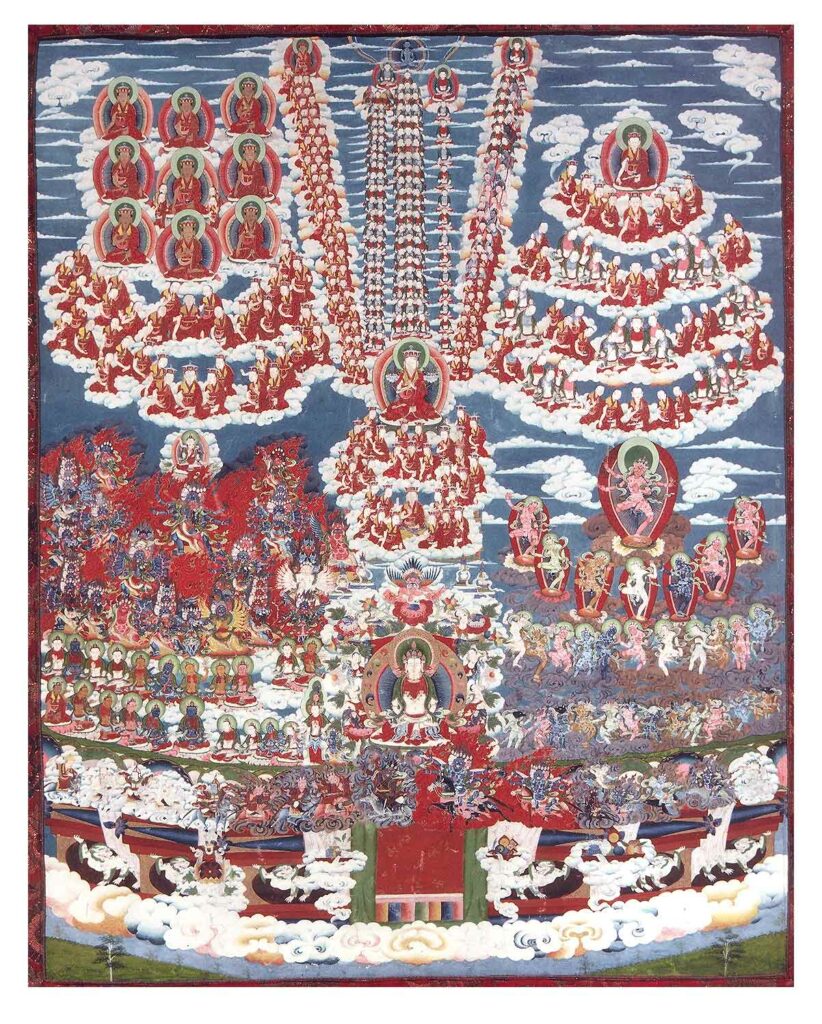The Three Refuges
The idea behind taking refuge is that when, for example, it starts to rain, we want to find shelter. The Buddhist shelter from problems and pain is threefold: the Buddha Samgye, his teachings, the Bon Dharma and the spiritual community, Sangha YungDrung Sempa. When we have some understanding about the nature of suffering, we will also have confidence through these teachings, that the Buddha, Dharma and Sangha – “Three Jewels“- can help us.

We want to be free from suffering, now and in future lives. When we understand the frustrating nature of all life, we want to be freed from cyclic existence in general. In addition to relieving our own suffering, we also wish that all living (sentient) beings be freed from suffering.
The analogy of sickness is often used: Buddha is the doctor; Dharma is the medicine; Sangha is the nurse; we are the patient. The the cure is taking the medicine, which means understanding the nature of suffering and practicing the methods that are taught to us. Taking refuge is similar to unpacking the medicine and deciding to follow the doctor’s advice.
THE BUDDHA – SAMGYE
Buddha means enlightened or awakened. A Buddha is a person who has purified all defilements and developed all good qualities. A Buddha is totally free from obscurations and suffering after traveling the entire spiritual path. Buddha started as an ordinary person and generated infinite compassion and equanimity to arrive at a state of highest bliss, and omniscience. But, as the Buddha himself said: “I cannot do but point the way” – if we don’t take the medicine, the doctor is helpless, but what better doctor could we have than an omniscient one?
THE DHARMA – BON
Dharma is a Sanskrit word, meaning doctrine, law or truth. The word Dharma has many different connotations, but in the Buddhist sense it represents the Buddha’s teachings. The Dharma is the ultimate medicine against all suffering.
THE SANGHA – YUNGDRUNG SEMPA
The Sangha refers to the spiritual community. It is defined in various ways, including:
- Whole community of ordained and lay Buddhists. This is however not the traditional use.
- More restricted: ordained Buddhist practitioners (monks and nuns).
- Most specific: persons who have direct perception of emptiness (ordained or lay).
- The Sangha, are like other travellers who are on the same spiritual path, and we need one another’s support just as we need the help of nurses for support and advice. They are our spiritual friends who can help us stay on the right path, can share their own experience and can help us when we are in crisis.
Ceremony Overview
Taking Refuge is a relatively short ceremony (< 30 minutes) and is usually offered in conjunction with retreats and workshops.
GesheLa will guide you through these steps of the ceremony. This is an outline of the event:
- Together, prostrate 3 times to the Refuge Lama to receive a blessing through him or her, from the three jewels of Buddha, Dharma and Sangha.
- Sitting in a comfortable place, receive the transmission of the Refuge mantra and prayer from the Lama. GesheLa will give transmission by saying each of the mantras, & will ask you to repeat after him: Outer refuge (3 times), Inner Refuge (3 times), Secret Refuge (3 Times), Long Refuge Mantra, Short Refuge Mantra.
3. GesheLa will tell you when it is your turn to receive your Tibetan name. You will be sent a copy of your certificate by email prior to the refuge and a hard copy will be mailed to you if you so choose. Following the weekend, Geshe La will sign certificates and they will be mailed to each new participant.
Please note that when you are in front of the Lama online, you should bow slightly (or kneel down) so that your head is lower. This is to receive the blessing and a Bon Dharma name from your Refuge Lama. If we were face to face you would present a kata to GesheLa and he would return it to you and you would leave a donation if it’s possible for you if you are able.
4. Once everyone has taken refuge, GesheLa will instruct and guide everyone in chanting the refuge mantra three more times together.
5. Finally, you will chant the Dedication Mantra together.
